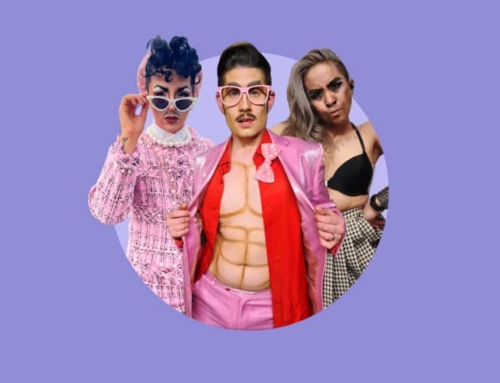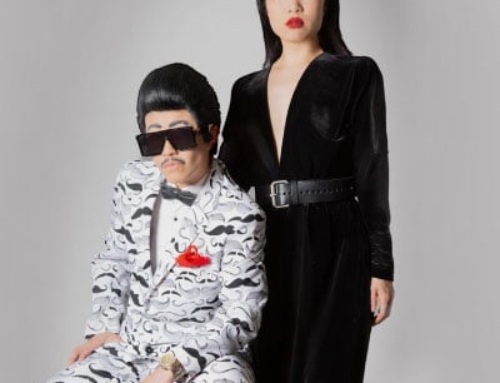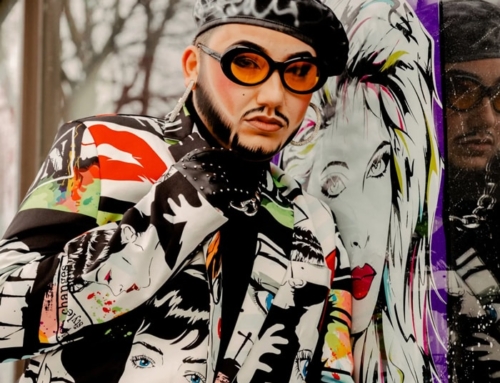
The Case for the Kings
RuPaul’s Drag Race all but defines what drag is and who can perform it. The world’s best drag kings would like a word.
Beau Jangles, the self-styled “fuckboy for your great-grandaddy’s generation,” sings into an old-fashioned microphone in a South London tavern. Wearing a three-piece suit with tails and a purple cummerbund, he clutches a glass of scotch in one hand as the diamond in his cravat winks and the smooth curls on his forehead swing rakishly. He flashes a glowing smile at a woman in the audience. She sighs dreamily at the king’s antics, recalling a time of crooners like Stormé DeLarverie.
In a recording studio, Chicago-based Tenderoni pops and swings to a professionally choreographed number, effortlessly lip-syncing to R&B. His purple eyeshadow with pronounced shoulder pads, silver harem pants, and red leather gloves cut quite the figure, like a 21st century Boy George.
At Europe’s premiere drag convention, a horned man with an enormous purple mane and beard flips backwards off a chair. He lands hard on his four-inch platform sandals and stomps ferociously across the stage, the panels on his Roman leather skirt flying wide. Oedipussi Rex, the “beardy drag barbarian,” then starts to growl out Leonard Cohen’s “Hallelujah,” encouraging the audience to sing along.

It’s mid-April, and we are nearly done with the 14th season of RuPaul’s Drag Race. The candidates—drag queens of every stripe—sashay and vogue through the show. To be sure, they are masters of their craft, talented figures of joy who have worked hard to get to this stage. Yet, one cannot help but sense the repetition. For the past decade and a half, one drag queen after another has fought for this title, while dynamic drag kings like Beau Jangles, Tenderoni, and Oedipussi Rex remain absent from our screens, hidden in the most part from the mainstream.
The frustration is widespread. “I’m not sure if I could name you a single drag king who thinks that Drag Race is in any way a true, inclusive reflection of drag as it is,” Beau Jangles told Jezebel. “I’ve heard many performers who do fit the Drag Race mold, even some who have been on the show, sigh at its lack of inclusion.”
Among Drag Race’s fourteen drag queen contestants this year was Maddy Morphosis, the first cisgender, straight man to join the show. Maddy Morphosis’s right to be a queen wasn’t the debate for many kings. In an email with Jezebel, Tenderoni said, “I think Maddy could show a different perspective and might even introduce some viewers into a different concept of what drag culture really is: a mixed bag.” Yet few noticed that Kerri Colby and Kornbread “The Snack” Jeté were also cast, making it the first time that two trans women of color would compete at once. It felt as if the sensation of Maddy’s casting upstaged this historic moment. More than that, Maddy’s casting was just another example of how the show continued to exclude specific groups of drag performers while reinforcing antiquated ideas about what drag is and who can perform it.
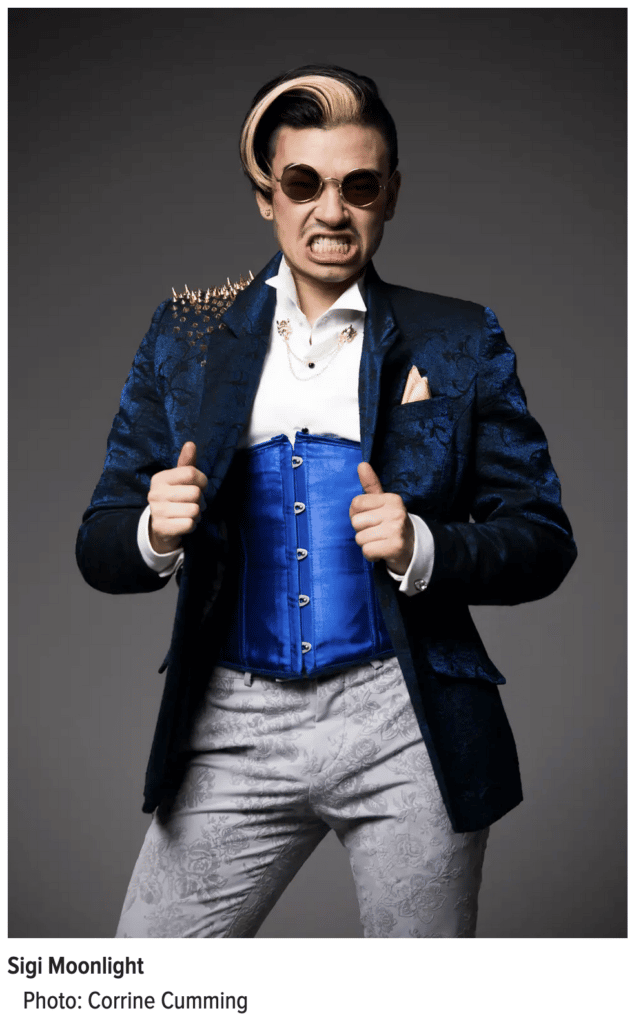
In the past, queens were cisgender men dressing as cisgender women, and drag kings were thought of as cisgender women dressing up as cisgender men. But the old guidelines of who can perform what kind of drag have gone out the window, along with the assumption that gender and sexuality exist within a strict binary. It’s no wonder that many are turning to drag as a creative tool of self-expression and liberation from the bounds of living in a heteronormative society.
“Most people who are drag kings very likely experienced oppression or misogyny from the kinds of characters they are portraying,” mused Beau Jangles. “So, either they tend to lean into that problematic thing, or they display what healthy masculinity could be—or in the case of nonbinary and trans drag kings, showing off your own masculinity and embracing it after society has told you that you can’t have it.” Drag has become a livelihood, a profession for a whole host of LGBTQ+ people, and for some, it’s the only place where they feel they can perform.
To Sigi Moonlight, a London-based king and member of the queer, pan-Asian cabaret collective the Bitten Peach, Maddy’s casting on Drag Race was a cop-out that “fulfills everything that people might think is needed to bash a heteronormative society,” he told Jezebel via email—“people” meaning the general public who may be unfamiliar with the lived realities of queer politics and identities. “But to those of us who do actually make up the people the show tries to represent on a global scale, it really does the opposite of reflecting that.”
Most people who are drag kings very likely experienced oppression or misogyny from the kinds of characters they are portraying. So, either they tend to lean into that problematic thing, or they display what healthy masculinity could be.
“This casting choice shows just how sexist the show’s perspective really is,” said Hugo Grrrl, a king who recently won New Zealand’s House of Drag. “In their minds, men are people who do drag the best. That’s problematic as fuck.” LoUis CYfer stressed that queens are often advocates for kings like him. “It’s just RuPaul. I just don’t think he’s seen one that he likes enough yet, to be honest.”
This simmering discontent hasn’t emerged from nowhere. For years now, controversy has raged over Drag Race’s lack of inclusiveness. In 2017, Peppermint became the first trans woman queen to join the show. The following year, RuPaul was asked by the Guardian how a trans woman could be a queen. RuPaul clarified that Peppermint had yet to “really transition” before competing on the show, asserting, “You can identify as a woman and say you’re transitioning, but it changes once you start changing your body. It takes on a different thing; it changes the whole concept of what we’re doing.”

These misguided remarks were met with intense backlash, and RuPaul issued an apology statement. In the following years, Drag Race made pronounced efforts on the inclusivity front. The first season of Drag Race UK cast Scaredy Kat, its first openly bisexual contestant. For its second season, Bimini Bon Boulash and Ginny Lemon, both nonbinary performers, joined, and in the third season Victoria Scone became the first cisgender lesbian to enter the race as a queen. Last year’s season in the U.S. saw Gottmik, the show’s first trans man competitor. These precedents, among others, are hugely positive.
But further questions over the show remain, and nobody could pretend it broadcasts real representation. This reality is obvious in the fact that only persons pantomiming femininity—drag queens—have been accepted into the race. In other words, where are all the drag kings?
Finding Male Pantomime
Performers have been challenging the age-old sentiment that men are the best interpreters of drag for nearly 200 years in the United States. At certain times, these performers gained notoriety for their work, even fame. But the whims of a patriarchal society—founded on fragile, easily bruised masculinity—are always mercurial. Time and again those who made it into the spotlight were pushed back into the shadows when they crossed the line from novelty, to a legitimate threat to the powers that be.
In terms of the historical archive, “drag kings” are relatively recent—Drag King History says the term first appeared in print in 1972. “Male impersonation,” however, dates back to the 1870s in America, when it became a wildly popular theatrical craft that attracted both straight and queer women alike for its potential to offer versatility on the American variety stage. Through impersonation, they could abandon the limited roles permitted to actresses at the time; they could be comedic and entertain audiences into old age. But according to Jack Halberstam, a professor of gender studies and English at Columbia University, being a drag king (or in this case, male impersonator) was considered “a kind of threatening performance” within a patriarchal society. “If femininity is a devalued form of expression,” he told Jezebel, “then anyone can get in on it. But if masculinity is a protected and privileged form of expression, then there will be restrictions on who can do it.”

For a time, caricaturing the top of the social order—wealthy, upper-class white men—made 19th century male impersonators a hit amongst middle-class and working-class men, said Gillian Rodger, author of the magisterial Just One of the Boys: Female-to-Male Cross-Dressing on the American Variety Stage. The attention the craft’s luminaries received was huge, and its big stars—figures such as Annie Hindle and Ella Wesner—made lucrative careers appearing on cigarette adverts and modeling male clothes. Thousands of young women purchased posters and wrote adoring letters to them.
Their days were always numbered. “The men, and their willingness to see caricatures of themselves, determined the popularity of the impersonators,” Elyssa Goodman, author of the upcoming book Glitter and Concrete about drag history in New York, told Jezebel. In moments of socio-economic tension between the lower and upper classes, such as the Long Depression and the Prohibition, and in moments of artistic proliferation, such as the Harlem Renaissance and the Pansy Craze, male impersonation was in vogue. Conversely, when masculinity was either threatened or had undergone trauma—like during women’s suffrage, the Great Depression, and the post-WWI period—male audiences grew disinterested in seeing it made fun of. Bound by such patriarchal restrictions, male impersonators fell out of favor. The most crushing blow seemed to come in the 1930s, when Hollywood published a list of self-censorship that de facto included cross-dressing. Male impersonation could no longer exist in the limelight—be it on the stage or the silver screen.
In their minds, men are people who do drag the best. That’s problematic as fuck.
This is not to say that the tradition died; Rodger pointed out that while it was no longer acceptable for white, American theater performers, many considered “other” or “exotic” enough were able to waive the rules. Foreigners like Greta Garbo and Marlene Dietrich, for example, appeared in films in three-piece suits. But it was the Black community that best maintained and reinterpreted the tradition of male impersonation through the 20th century. In Harlem’s cabarets, audiences were thrilled by the queer and trans performances of singers like Gladys Bentley. Shaped by the Harlem Renaissance and openly lesbian, Bentley dressed as a man both on the street and the stage, performed for Black and white audiences alike, and frequented famous venues like the Apollo and the Cotton Club. She was one of the highest-paid Black woman of her time, yet she was not immune to the fragility of social expectations; during the vindictive years of McCarthyism, she took to wearing dresses. In 1939, the Jewel Box Review, America’s first racially inclusive traveling cabaret, hit the road with 25 female impersonators and, crucially, one male impersonator: Stormé DeLarverie, who served as its MC in the ‘50s and ‘60s. She befriended Billie Holiday, was photographed by Diane Arbus, and—rumor has it—threw the punch that ignited the Stonewall Riots.
Male impersonation also found an unlikely home in venues operated by the Mafia. With the end of Prohibition, speakeasies were no longer necessary, but serving alcohol to homosexuals remained illegal, so the mob started running gay and lesbian nightclubs. It was a solid, bilateral trade: The mob got their money, and the queers had their spaces, free from harassment. In lesbian bars located in the West Village, it was often the case that both wait staff and performers were male impersonators. Blackie Dennis, often compared to Frank Sinatra, was both a popular employer and an important nightclub headliner of the time.
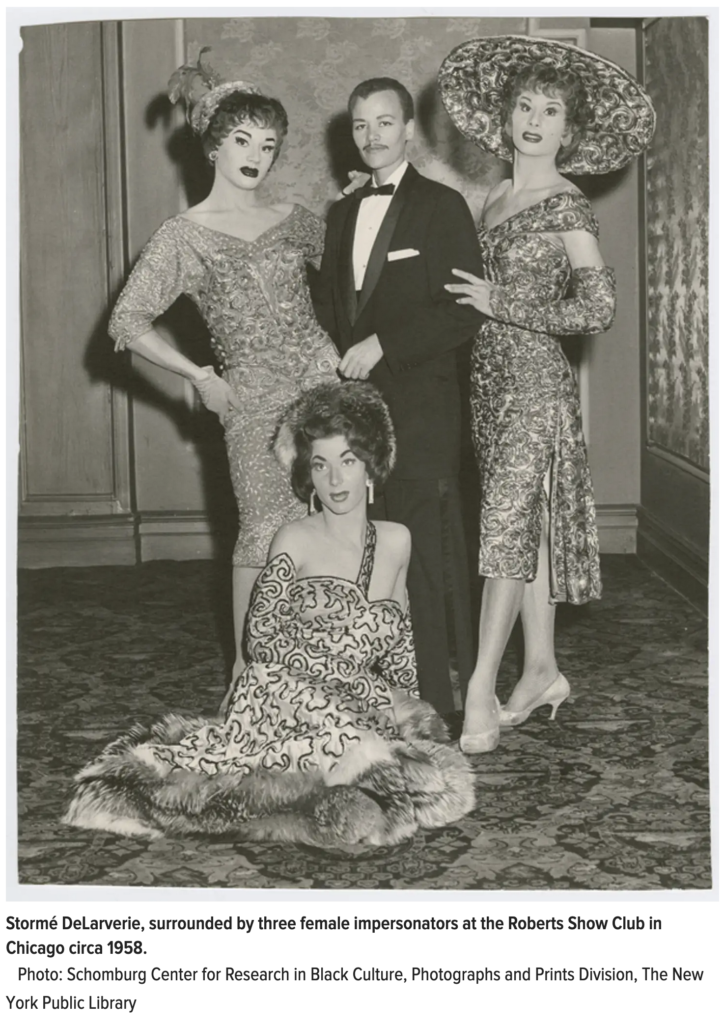
The dark days of the AIDs crisis molded modern-day kings, according to Halberstam. As AIDS tore through the gay community, many gay men were hesitant to frequent clubs. “In San Francisco,” Halberstam said, “there were a series of very high-profile gay clubs where you wouldn’t even see women before the AIDS crisis. During the crisis, Friday night was given over to women, because that’s what the crisis meant. Men were not going out.” At these “women’s nights,” queens like Mistress Formika began to take women under their wing to train them in the art of drag. At the same time, drag queen performance was about “protest, visibility, and defiance,” said Goodman, as much as it was about “people just having a good time in the face of devastation.” The moment, she argued, “was a siren call to be yourself and create what you wanted to create, however you wanted to do it, and live however you wanted to live—because tomorrow you could be dead.”
The queens passed on their skills in drag, as well as that siren call to be oneself, to the kings, who answered in kind. Through costume, makeup, and performance—the influences of Johnny Science and Diane Torr were pivotal here—the ‘90s drag king generation emerged. Up until this point, impersonation had been about accurately depicting a man. Kinging was about interpreting, defining, and challenging masculine roles often through caricature or exaggeration. Mo B. Dick, a founding father of the modern drag king movement, famously said, “Instead of being an angry woman, I became a funny man.”
In 1995, Mo B. Dick opened Club Casanova in New York, the first weekly variety show dedicated to kings. It became an instant sensation; Halberstam recalls photographers and New York Times journalists jostling for front row positions at 2 a.m. on Sunday night, with every performer firmly confident of their immediate stardom. However, despite the club’s large crowds and success (albeit short-term; it didn’t last two years), Halberstam said, “Audiences want camp…and straight audiences did not get the sexiness of queer masculinity.” They struggled to understand what they were seeing. “[They] wanted the big reveal at the end—the equivalent of the drag queen pulling her wig off.” Soon enough, the straight contingent lost interest in the kings, and journalists went off in search of the next party to crash.
IF FEMININITY IS A DEVALUED FORM OF EXPRESSION, THEN ANYONE CAN GET IN ON IT. BUT IF MASCULINITY IS A PROTECTED AND PRIVILEGED FORM OF EXPRESSION, THEN THERE WILL BE RESTRICTIONS ON WHO CAN DO IT.
In the intervening years, drag as an artform has skyrocketed in popularity. Within this zeitgeist, the kings have come back into the spotlight. The media, capricious as it may be, has returned to courting them, too: In the last year, the Guardian, them, and the New York Times all but cited them as the hottest new thing in drag. But, historically speaking, we have seen similar moments where they (or iterations of them) became wildly successful, garnering fame, fans, and wealth, before it stopped. The constraints of western patriarchal society said, “Okay, you’ve had your fun being a man, it’s time to stop now. You’ve gone too far.” And what the patriarchy says, goes. The burning flame of drag kinging gets tamped down.
RuPaul’s continued dismissal of them tamps down that flame once again, right when it is vital for kings (and things, and queens, and anyone who doesnt fit RuPaul’s plastic, candy commercial mold) to fight for visibility on this globally recognized stage. Taking this stage would be part of an overall activism against the kinds of forces that have suppressed them in the past. It would, by extension, prevent history from repeating itself.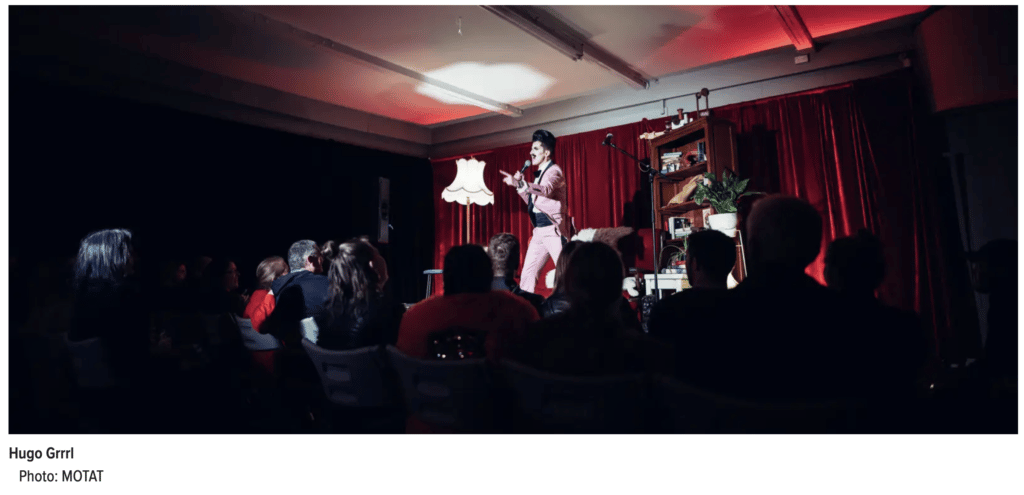
The RuPaul Moment
As both a performer and showrunner, RuPaul has transformed drag into a livelihood, with practitioners constantly upping their game to near Olympic levels of innovation, showmanship, and craft. It’s therefore surprising to learn that drag queens as a mainstream form of entertainment—at least as we’ve seen it in the last 30 years—is a relatively new phenomenon.
Things were tenuous for queens when RuPaul released her iconic music video for “Supermodel (You Better Work)” in 1992, her first major breakthrough. In 1995, the designer behind RuPaul’s costumes filmed a Levi’s commercial in drag, which the American media collectively refused to air on network television. Though popular 1990s movies like To Wong Foo, The Birdcage, and even Mrs. Doubtfire, and documentary Paris Is Burning, had depicted queens with differing levels of sympathy and integrity, it was still considered a practice that existed in the margins of society. Suddenly, with the premiere of The RuPaul Show on VH1 in 1996, Americans had a drag queen in their living room interviewing Cher and Diana Ross. “People saw that making a living in drag was in some way possible,” Goodman said, and drag performers began coming out of the woodwork.
Then came Drag Race, which premiered in early 2009. Immediately it was a sensation, encouraging a new generation to embrace and express their LGBTQ+ identities, many of them through drag. The framework it deployed, however, fundamentally was structured around cisgender males performing femininity, distorting the general public’s perception of what drag was, and the range of genders, races, and ethnicities who could perform it. Simply put, men performed drag, and drag = drag queens.
But in Britain, you’ll find Sigi Moonlight, a chameleon king who can expertly transform into a series of characters: the Kung Fu master sporting a fu manchu, the 1920s boxer with an old-timey unitard, the Korean dictator, and the gangster, to name a few. In America, people can be amazed by Landon Cider, a contemporary “monster” king and makeup artist whose mind-boggling transformations include an alien with iridescent eyes the size of kiwis, a yellow-fanged gremlin, and a bloodied white bunny. In a 2021 interview with the New York Times, Mo B. Dick heralded this new generation: “These kids today, I’m pleased at how extraordinary they are,” he said. “Now, there’s more artistry and more makeup. Being a king is more ‘draggy.’ The showmanship is phenomenal.” All can see Drag Race’s oversimplification does not meet the real quality of kings out there today.
Making the Shift
Anyone can be a drag king, queen, or thing (yes, there are drag things; aliens, mythical creatures, you name it). The result of this is a glorious mess—a cacophony of performance styles manifested through varied groups participating in a craft that espouses freedom of expression, individual creativity, and shifting identities. When Drag Race, and other pageants, exclude them, the implication does not only seem to be that their interpretations of drag are invalid, but so too is their LGBTQ+ identity. After all, dragging has historically been a safe, queer space to express the self.
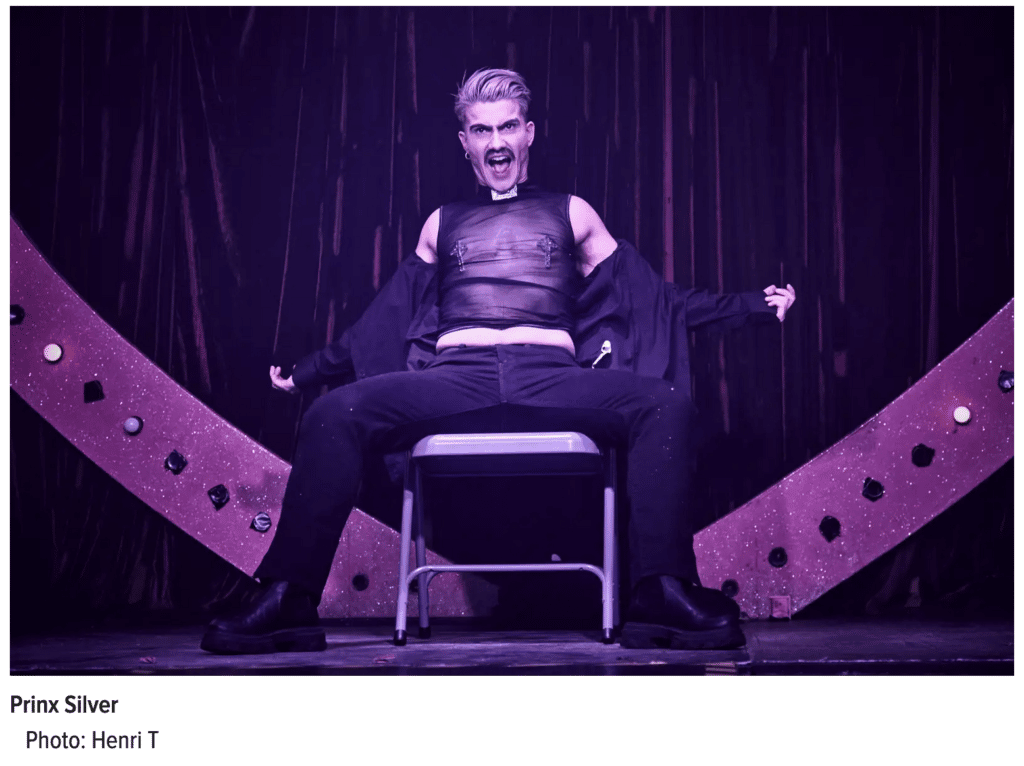
Major drag competitions are already making the shift to broader inclusivity. In 2018, Hugo Grrrl won House of Drag. In 2019, Landon Cider won Dragula and was crowned “World’s Next Drag Supermonster.” Prinx CHIYO, an Afro-Latinx drag king, became the first trans person to compete in the Mr. Gay World. Prinx Silver took the scene by storm in 2019 after winning silver in the Gold Rush and runner-up in the Man Up competitions. In 2021, drag queen superstars Alaska and Lola LeCroix welcomed kings into Alaska’s Drag Queen of the Year. “Lola and I initially set out to do this pageant as an experiment,” Alaska told Entertainment Weekly. “What would happen if we held a competition that welcomed all different types of drag performers, regardless of their gender identity or anatomy or history—all on the same stage?” Last year, Tenderoni took home the prize. And on Hulu’s Life and Beth, HBO’s Somebody Somewhere, and Fox’s Welcome to Flatch you’ll find Murray Hill is making drag king TV history.
If a minority drag performer is left out of the show, they struggle to get hired. They are, in effect, a less valuable commodity.
In a recent article for Metro, celebrity queen from Drag Race UK Bimini Bon Boulash said, “There needs to be kings on there.” Yet many—scholars, audience members, drag performers—express skepticism over the need to bother with RuPaul at all. If other competitions welcome them, the argument goes, why do they need Drag Race? After all, it’s just a single show. “Separate but equal doesn’t work,” Beau Jangles said. For him, it is a question of resources and space: “[They] will not be allocated to us the way they are allocated to shows like Drag Race. We are not starting off with an equal platform.”
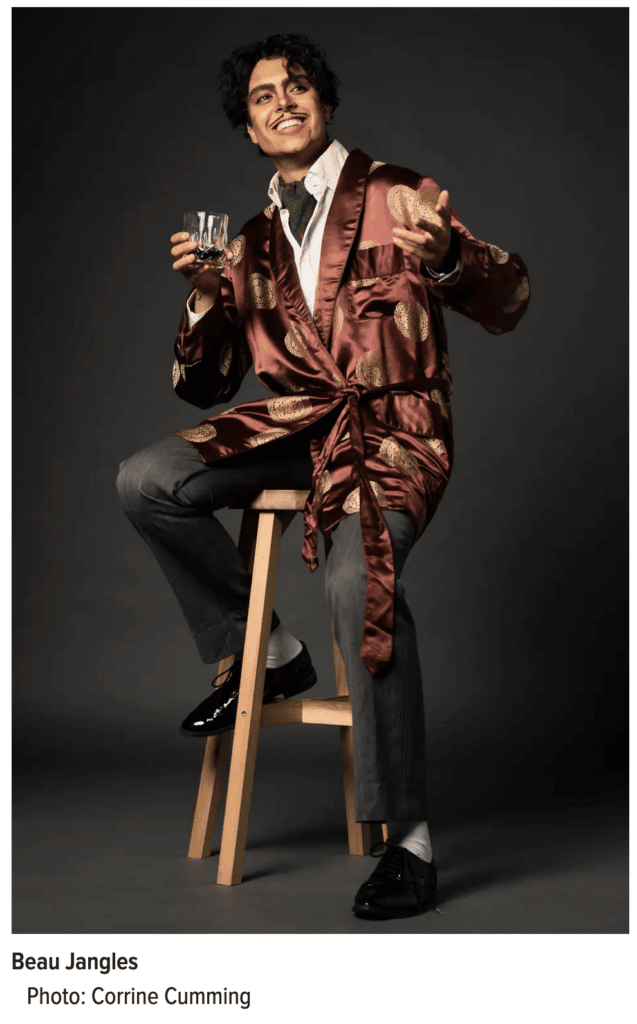
There is profound truth to this, not least because the show has an enormous economic impact on the drag industry. “She positions herself as the gatekeeper of drag,” Beau Jangles said of RuPaul. “The be all and end all! What she says is, drag goes.” Denying kings the same platform has a genuine “trickle-down” effect that damages local scenes and tanks opportunities for drag kings, he argued. “On a regional and local level, booking agents look to what Drag Race chooses as an example of who to select for their gigs. If a minority drag performer is left out of the show, they struggle to get hired. They are, in effect, a less valuable commodity.”
You could also ask: If Drag Race is organized around the pantomime of women, how could the show be reoriented to include a pantomime of men? The layout of the pageants would, according to Hugo Grrrl, look “exactly the same!” “We fundamentally do the same art form. There wouldn’t need to be any change to the format of shows like this for drag kings to be easily included, perhaps only a long-overdue update to the gendered language often used.” Tenderoni wants “more creative-based challenges” like sewing, painting, and dancing added to Drag Race so kings and queens could compete together. “This would show [the world] a lot of the hard work it takes behind the scenes to do drag.”
Hard work, indeed—and hard work that has been performed for at least the past two centuries in this country by impersonators and kings, whether in or out of favor. Historically, it has been cisgender, straight men who, after losing interest in seeing their masculinity parodied, closed the doors of opportunity to impersonators. One may wonder who is doing the gatekeeping and the barring today. Studio executives? Straight audiences who favor queens? Or is it a contingent of the cisgender, gay male population who cannot accept drag kinging as a valuable craft?
As Goodman put it, “A person in drag is always punk rock, a fuck you to misogyny.” Indeed, the pageantry of drag kings, drag things, drag monsters, enby, afab, and disabled performers, is an exhibition of their vibrant presences in our contemporary, patriarchal landscape where, let’s face it, masculinity could use some parodying. If RuPaul were to welcome a broader range of performers onto her show—opening the doors of the mainstream—it would be an act of defiance in the face of misogynists, transphobes, and state legislators who, ultimately, want us all back in the closet. It would be a brilliant reminder of the old adage that unity is strength.
Amanda Chemeche is a queer writer and folk musician living between Edinburgh and NYC. A Yale and Trinity College Dublin alumni, they are currently working on their first book and completing a Creative Writing MFA at Columbia University.


